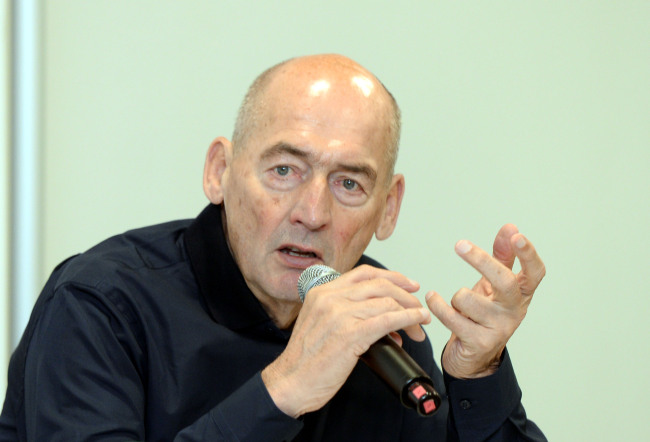[Design Forum] Seoul is city in an 'impossible place’
By Korea HeraldPublished : Nov. 27, 2014 - 21:31
As one of the greatest architectural figures in modern times, Rem Koolhaas has designed structures that can be seen in major cities across the globe. Founder of the architecture firm OMA and a Harvard University professor, Koolhaas is widely considered one of the world’s most influential architects and is the mind behind the visually perplexing CCTV Headquarters building in Beijing as well as the Seoul National University Museum of Art.
The architect, who was one of the keynote speakers at this week’s Herald Design Forum, stresses the importance of learning history as a means of developing sound architecture and that understanding the culture of the city in which one is creating a new structure is a crucial element to having a design that enhances the cityscape. The 70-year-old Koolhaas estimates that he has probably traveled to Seoul around 50 times.
“What I like about this city is that it is a city in an impossible place,” Koolhaas said in a round table interview following his design forum presentation on Wednesday. “It’s a city in a place where there are mountains and I think this combination is really exciting, particularly the part of Seoul where you have a mountain range and a city that tries to exist around it.”
The architect, who was one of the keynote speakers at this week’s Herald Design Forum, stresses the importance of learning history as a means of developing sound architecture and that understanding the culture of the city in which one is creating a new structure is a crucial element to having a design that enhances the cityscape. The 70-year-old Koolhaas estimates that he has probably traveled to Seoul around 50 times.
“What I like about this city is that it is a city in an impossible place,” Koolhaas said in a round table interview following his design forum presentation on Wednesday. “It’s a city in a place where there are mountains and I think this combination is really exciting, particularly the part of Seoul where you have a mountain range and a city that tries to exist around it.”

“What really makes me happy is driving on this mountain range and seeing all these shifting perspectives of the city, making it very diverse and beautiful,” he added.
The architect admitted that in his many ventures to Seoul for both work and leisure, his experiences and perspectives of the cityscape have constantly changed. He claims that his initial negative perceptions of the urban area’s structural landscape more than two decades ago have now shifted to a more positive outlook.
“For instance, you could say the typical and repetitive social housing in Korea may not be hateful, but negative,” Koolhaas said. “Twenty years ago I was actually astonished by the uniformity and the repetition, but now coming 20 years later, I really think it’s almost a relief.”
“Because now everything else in the world has become so diverse, now it (Seoul) looks so serene and sober,” he continued. “This is also why I cannot say ‘most’ or ‘least’ or ‘worst’ or ‘best.’ Our perception of everything is constantly changing and so it’s a collaboration of all these elements.”
As part of his own personal policy, Koolhaas states, he tends never to comment on other people’s works because as an insider, he understands the tremendous complexity, dedication and exhausting effort that goes into each and every project. However, in terms of his recent visit to the newly unveiled Dongdaemun Design Plaza, also referred to by some as Seoul’s “spaceship” landmark, Koolhaas was willing to make one comment about the structure.
“Architecture today is a very difficult profession, so I consider real-life projects impressive,” he says. “And to do something on this scale in the heart of Seoul, I can only imagine how complex it must have been … so therefore, it was a major achievement.”
One of Koolhaas’ most iconic structures, Beijing’s CCTV building, was in the spotlight recently. Early this week, officials from China’s Communist Party announced their future agenda to snub what they consider to be “bizarre architecture.” Officials called out Beijing’s famous “Bird’s Nest” National Stadium and Koolhaas’ widely celebrated design as examples of unacceptable architecture, claiming them to be “incompatible with Beijing’s culture.”
“It’s a very ambitious way of thinking about structure and technology in a way that will also create new possibilities in China,” he responded in his design’s defense.
Koolhaas states that he soon hopes to be able to have a discussion with China’s President Xi Jinping to further elaborate his belief that the design of the CCTV building does in fact add to the urban cohesiveness of the city of Beijing.
“It’s a very positive contribution to the Beijing cityscape in a sense that it’s a building that’s not the same from any angle,” he added. “Therefore, it creates a kind of life in the city that hasn’t existed before.”
By Julie Jackson (juliejackson@heraldcorp.com)
-
Articles by Korea Herald








![[Graphic News] More Koreans say they plan long-distance trips this year](http://res.heraldm.com/phpwas/restmb_idxmake.php?idx=644&simg=/content/image/2024/04/17/20240417050828_0.gif&u=)
![[KH Explains] Hyundai's full hybrid edge to pay off amid slow transition to pure EVs](http://res.heraldm.com/phpwas/restmb_idxmake.php?idx=644&simg=/content/image/2024/04/18/20240418050645_0.jpg&u=20240419100350)








![[KH Explains] Hyundai's full hybrid edge to pay off amid slow transition to pure EVs](http://res.heraldm.com/phpwas/restmb_idxmake.php?idx=652&simg=/content/image/2024/04/18/20240418050645_0.jpg&u=20240419100350)

![[Today’s K-pop] Illit drops debut single remix](http://res.heraldm.com/phpwas/restmb_idxmake.php?idx=642&simg=/content/image/2024/04/19/20240419050612_0.jpg&u=)